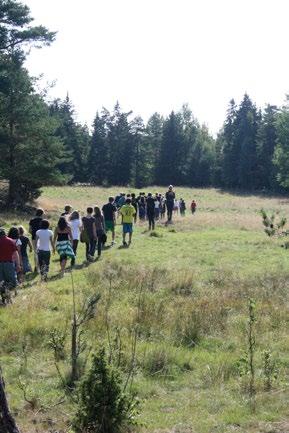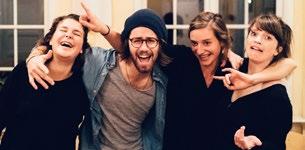5 minute read
Not a Waldorf Kid
Next Article
by Kailea Frederick
I am not a Waldorf kid. My schooling took place in the public school system in Hawai`i. The early years, elementary school, were sweet. I remember the giant lawn that wrapped around the back of the property where I caught ladybugs and played tag. One of Dole company’s massive pineapple fields lay across the highway, and on hot afternoons we would wander into the fields of red dirt looking for a ripe pineapple to make our own. My school was small, I knew everyone and everyone knew me. I loved my teachers and enjoyed being an integrated member of the student body.
Intermediate school was far, and big. The shift was shocking on multiple levels. Kids I had grown up with turned mean overnight, friendships were easily lost. Kids were carted away during recess, physical fights were normal, teachers who would scream inches away from your face were part of daily life. I was a good student, but I began to struggle as an all-encompassing fear took hold of me.
High School only got worse. During 9th grade, I suffered an emotional breakdown and sank into depression. At only 14, I couldn’t articulate what I was going through, and with a student body of close to a thousand it was easy to fall through the cracks. For the next year and a half my parents struggled to keep me in school, completely unaware that it was at school where I was being introduced to drugs. Staff members’ main way of attempting to bring control to classes always on the brink of outbreak was through intimidation. I remember thinking that my teachers and staff represented most adults in the outside world. I sank further into depression, drinking and drug abuse.

At 15, I was living between friends’ houses as my relationship with my family began to fall apart. By 11th grade, teachers unsure what to do with me would give me library passes, hoping not to have to deal with yet another unresponsive student during their class hours. Seeing that school was failing me, my mother said one day, “Kailea, why don’t we get you out of here, get your GED, and enroll you in community college.” I was both flooded with relief and intimidated by the idea, but it was obvious I wasn’t going to make it to university by staying in my current situation. A month later, I passed my GED exam and was at our local college for spring semester.
As a teenager with barely any life experience, I had no clue who I was or what I wanted to be. I couldn’t connect with my educational experience and I began to believe that I was simply not smart. I began to create my own life. I rented my own house and made friends outside of my high school peer group. I still didn’t know where I was headed, but I was discovering a deep curiosity about the world. Books transported my mind to distant places where wars took lives and the cry for life made my own feel small in comparison. I wondered what my own hands might be capable of. Could I contribute something of value?

I began searching actively for a place that could harbor some of these secret thoughts. Right before my 20th birthday, my father’s friend called me excited to share the experience of her visit to a program in Sweden called The International Youth Initiative Program (YIP). I’ll never forget the moment she placed a flyer in my hands and encouraged me to apply. I hurried home and looked up YIP online. YIP described itself as a social entrepreneurship program and welcomed individuals between the ages of 18 and 28 to apply from around the world, I was intrigued. The program was organized around three core questions; “Who am I in relationship to myself? Who am I in relationship to others? Who might I be in relationship to the world?” These were questions I carried and I felt something in myself lift just knowing that a place like YIP existed. I had found a direction to move in.
It took two years to fundraise, save, and apply. I invested that time in completely re-orientating my life and focused on continuously asking what my contribution might be. In spring 2013, I received an acceptance letter and that fall I was on my way to Ytterjärna, Sweden, the anthroposophic campus where YIP takes place. From the first moments I stepped foot into our student house, I could feel I was exactly where I needed to be. I lived and learned under the same roof with 19 other participants from around the world. We quite literally did everything together, learning about possibilities that lie within community living and building. Conflict became a space of deep learning, instead of a space to avoid, as we navigated through the joys and challenges of our year together.

I realized how thirsty I was to be in a learning environment that welcomed me. One day could encompass singing, body movement, writing, and getting our hands in the dirt. An educational environment that took my whole being into consideration gave me confidence to believe in myself. I was able to witness, through my own and my peers’ unfolding, the importance of valuing different ways of learning. For the first time since my childhood an excitement for my future began to move through me. My YIP year was pivotal, my first experience coming into contact with my truest expression as a human being.
Today I am a facilitator for my own project called “Earth Is `Ohana,” where I get to pay forward my learnings from this cherished year. There is not a single day that I do not draw from the invaluable tool kit that this program made available to me. I am living my life’s work because of the support that the YIP organization and program provided me. There will never be enough ways to say, “Thank you.”

Kailea Frederick is a First Nations woman dedicated to supporting individuals of all cultures in remembering their ties to the earth. Growing up off the grid in Maui, Hawai`i, forever imprinted in her the importance of reciprocity through indigenous world-view. She feels raised by wild spaces and intimately tied to Honua, our island earth. "Earth Is `Ohana" is Kailea’s personal response to the many stories that continue to shape her. You can learn more about her work at www.earthisohana.com and about YIP at www.yip.se










